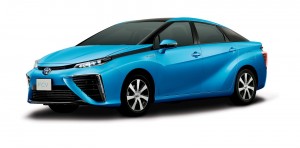The more I learn about hydrogen fuel cells as a potential alternative (or competitor) to battery electric vehicles, the more confused I become.
Hydrogen as a fuel source (as opposed to electricity) is much more energy intensive to produce and much less efficient as a result, given the energy input to make the hydrogen that will power the vehicle. It also requires building an entirely new fueling infrastructure to reach drivers, whereas electricity is ubiquitous (although does require a lot of new charging stations).
Hydrogen also isn’t cheap (per paywalled Greenwire):
Hydrogen fuel-cell vehicles could offer advantages over the electric cars on the road now, including higher travel distances between refuelings. Filling up the tank is basically the same as filling a car with gasoline, and in California, most hydrogen pumps are at existing gas stations. While the hydrogen fuel is significantly more expensive — filling a tank costs about $75 — Toyota and Honda give their customers credit for $15,000 worth of fuel over three years of ownership.
So why the big push for hydrogen in places like California, when battery electric vehicles have taken hold with billions of investment from companies around the world?
The answer appears to be Japan, and the automakers in that country, specifically Toyota and Honda. States like California have had to include hydrogen incentives in packages with battery electric vehicles in order to get the political buy-in from these Japanese automakers.
So with all the hurdles associated with hydrogen fuel cells, why is Japan so invested in the technology? Per ClimateWire (also pay-walled):
A big part of the answer is that the shift toward hydrogen plays to Japan’s strengths as a technology developer and exporter, and the country makes an ideal laboratory to test the hydrogen economy.
The country spends more than $100 billion on foreign oil every year, and fuel prices tend to be high, so hydrogen fuel doesn’t have to be as cheap as it does in other countries to compete. More than 93 percent of Japan’s population is concentrated in urban areas, so fewer fueling stations are needed to sustain a hydrogen fleet than among populations that are more spread out.
For drivers, a fuel cell fill-up takes only a few minutes, compared with hours of charging for a battery-electric vehicle.
Another factor is that much of the supply chain for the hydrogen economy is domestic, and Japanese companies like Toyota have a track record of bringing fuel-efficient cars to the masses.
In particular, Toyota has built the Prius, a mass-market hybrid gasoline-electric car that has dominated the segment for more than 20 years. It took 10 years to sell the first million units, then two years to sell the second million.
With patience and know-how, Toyota hopes to replicate some of that success in fuel cells in Japan and in other parts of the world where energy prices, environmental concerns and driving styles align to make fuel-cell-powered cars a preferable option.
I suppose it’s fine to have another “clean” vehicle technology in the mix, in case breakthroughs help it leapfrog battery electric vehicles. But I would prefer that policy makers don’t share too much of the limited available incentive dollars with this technology and instead focus on the more optimal solution.
Green Car Reports documents the challenges that drivers of hydrogen fuel cell vehicles are having finding functional stations:
Last year, the state of California committed $100 million over five years to building 100 hydrogen fueling stations in the state by 2020, in partnership with Toyota, Hyundai, and Honda, and private companies like First Element Fuel as well.
Early lessee Paul Berkman of Corona del Mar, for one, is frustrated.
He’s paying $500 a month for a vehicle he hasn’t been able to drive for five weeks, because all three hydrogen stations within 20 minutes of his home or workplace have been down for more than a month.
Berkman told Green Car Reports that the closest station, five minutes away at a Shell site in Newport Beach, has been “struggling”–and that at best it can only fill his Tucson Fuel Cell to half capacity.
Ten minutes away, a station by the University of California–Irvine campus has been closed for upgrades.
The California Air Resources Board issued a testy response to the article, which Green Car Reports included in an update. They cite the early trouble with plug-in electric vehicle stations, too, as an example of what they hope are just short-term problems.
Trouble is, public charging stations for battery electrics are also unreliable, even after a number of years of widespread usage. So that’s not exactly confidence-inspiring. The state will need to get this issue fixed, for both fuel cell and battery electrics, if it has any hope of encouraging widespread adoption of these technologies. But at least with battery electrics, you can just charge at home.



